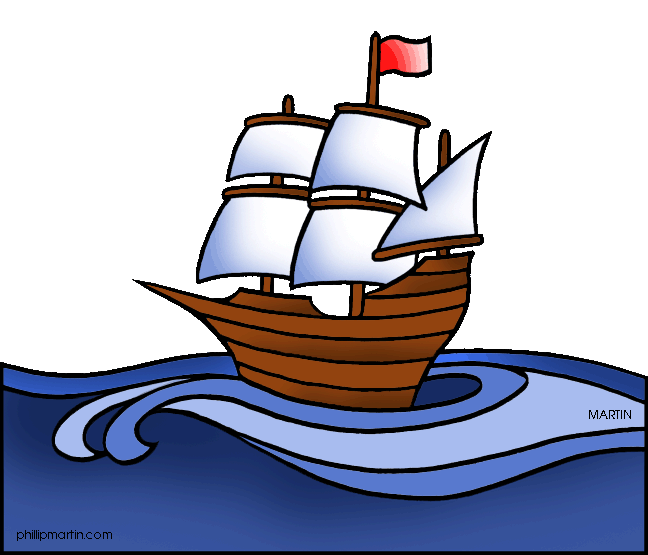For Kids
A small group of people, the Pilgrims, arrived in the New World from England on a rented ship named the Mayflower. They landed at Plymouth Rock, Massachusetts, on a cold day in December 1620. Back in England, everyone had to belong to the Church of England. The Pilgrims did not want to belong to the Church of England. They were seeking religious freedom.
There were only 102 people - men, women, and children - aboard the Mayflower. When they arrived in the New World, there was no one to meet them. What they found was a foot of snow on the ground, and a dense forest of trees along the shore. It had taken 8 weeks for the voyage. People were sick. Nearly half of their people died within the first week. While caring for the sick, those who could began to build a long cabin of logs, to act as a community home for themselves and their animals. They moved everything they had brought with them from the ship into this log cabin. The Mayflower had to return to England. It was only rented, with borrowed money at that. But it stayed in harbor long enough for the Pilgrims to unload and to bury those who had died.
Those who survived made wise use of nature about them - the land, the sea, and the forest. They found food. Come spring, they planted corn, which they received from the friendly local Indians. An Indian named Squanto was especially helpful. Squanto showed them how to plant corn, where the best fish could be found, and much more. This small band of people might not have survived without Squanto's help. But nothing would have made them move back to England, even if they could. In England, they had been imprisoned and harassed and suffered much for their religious convictions. They were determinded to make a home for themselves in the New World. With Squanto's help, and other friendly Indians, they did just that.
One day, a new tribe arrived. They handed the Pilgrims a snakeskin bag full of arrows. It was their way of announcing war. The Pilgrims sent back a bagful of bullets. Then, as quickly as possible, the settlers built a huge wall of logs around the village of Plymouth for protection. They locked the gate at night, and left men on guard. They expected trouble, but none arrived. They did not hear from these Indians again.
The first autumn was a cause for rejoicing. The Pilgrims had lived through the harsh winter. They had planted in the spring. They had made friends with the local Indians. And in the autumn, they harvested their crops, canned food, and prepared for the winter ahead. In November, they had a celebration. They ate deer, and wild turkeys, and corn, and bread. They went to church. And then they feasted. They invited their good friends, the Indians, to join them. That was the first Thanksgiving.
Before the end of November, a ship arrived from England, carrying more settlers. These settlers did not have to go through what the first settlers had experienced. These settlers were greeted by the first Pilgrims. The ship carried away a payment for the rent of Mayflower - beaver skins, boards, and codfish.
Over the next seven years, more settlers arrived in Plymouth. They brought cows and hogs and sheep with them. The people of Plymouth worked to gather goods to send back to England, each time a ship arrived, to repay the original debt as well as new ones created by the new settlers. At the end of seven years, although the debt was not yet repaid in full, Governor Bradford, who was in charge of the Plymouth community, went ahead and divided the good farmland beyond the village. He gave every family a plot of land, a farm of their own. That was a day of rejoicing! Each Pilgrim had earned a home in the New World.

